Dec 31, 2025
Dec 31, 2025
Director: Federico Fellini/ Italy/Italian/124mts
Federico Fellini's warmly nostalgic memory piece examines daily life in the Italian village of Rimini during the reign of Mussolini, and won the 1974 Academy Award as Best Foreign Film. This carnivalesque portrait of provincial Italy during the fascist period, the most personal film from Federico Fellini, satirizes the director’s youth and turns daily life into a circus of social rituals, adolescent desires, male fantasies, and political subterfuge, all set to Nina Rota’s classic, nostalgia-tinged score. The Academy Award–winning Amarcord remains one of cinema’s enduring treasures.
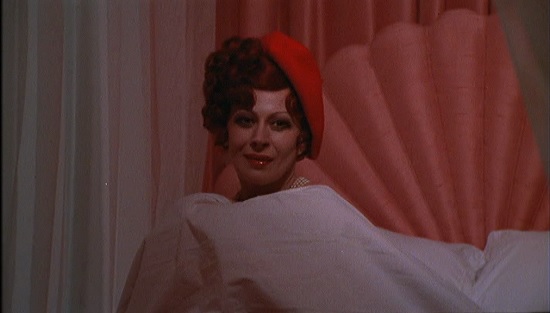
Gradisca waiting for the Prince
As critic Roger Ebert rightly says, “If ever there was a movie made entirely out of nostalgia and joy, by a filmmaker at the heedless height of his powers, that movie is Federico Fellini's ‘Amarcord’.” The title means “I remember” in the dialect of Rimini, the seaside town of his youth, but these are memories of memories, transformed by affection and fantasy and much improved in the telling. Here he gathers the legends of his youth, where all of the characters are at once larger and smaller than life — flamboyant players on their own stages.
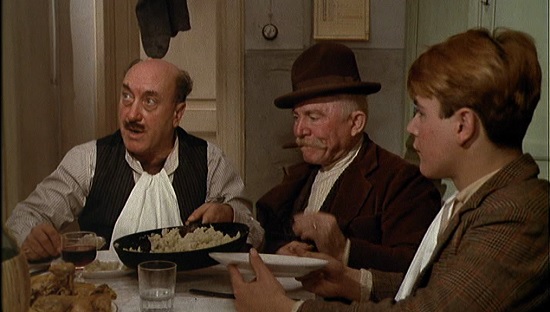
Patriarch Aurelio, Miranda's father and Titta at dinner table
From moment to moment and shot by shot, Amarcord delivers more sheer pleasure than any other Federico Fellini movie. That’s not to say it's his greatest film, or that anything in it rivals the emotional, lyrical, or metaphysical wallop of the finest passages in Nights of Cabiria, 8 1/2, La Strada, or even La Dolce Vita, the big early-‘60s crossover hit that made the director king of the international film world. But Amarcord was the last clear triumph of Fellini’s career, his prodigious gifts for phantasmagoria, amazing fluidity, and gregarious choreography all feeding an emotional core that caught at audiences' heartstrings and carried them away.
The film is ostensibly a memory-dream-diary of life in the director’s seaside hometown of Rimini during one year in the 1930s. But Fellini was an irrepressible showman who loved pulling the audience’s collective chain, and Amarcord is no more straightforward as a recollection of his real adolescence than Amarcord is a real word — Fellini made it up as a bit of pretend vernacular. Perhaps Amarcord works because, in mining his memories of growing up, Fellini connects with the adolescent impulse to make fun of everything, to jeer at authority.
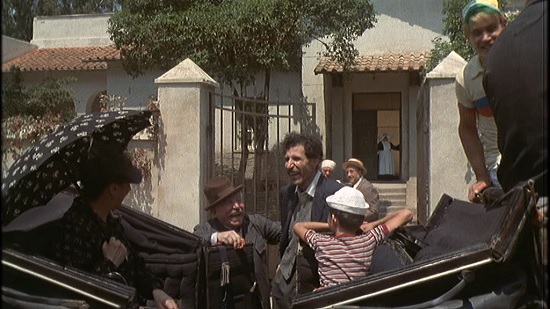
Ready for annual picnic with Uncle Teo
The town lawyer, a friendly, pleasant fellow, turns up to relate the town’s ancient history to us — and gets a raspberry or a snowball in the head for his troubles. Those missiles represent the best timing in the film, a schoolboy’s response to the endless crap our teachers always bored us with. Amarcord is full of lyric ecstasies — spontaneous parades, comic ceremonies and eye-popping surrealist moments — that exist principally because that is what a Fellini movie is supposed to be like. There’s no dominant story line, no individual character or player to be identified as the center of the film’s swirling movement. Yet we do get to “know,” and begin to cherish, literally dozens of goofy, eccentric, funny/sad creatures who have their distinct places in the continuum of Fellini’s made-up town and re-imagined Italy of a bygone era.
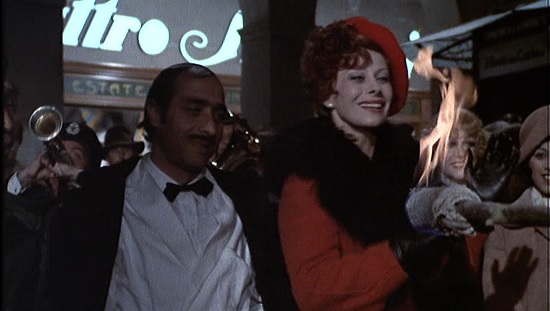
Gradisca lights bonfire – ‘burn the winter and the cold’
Amarcord uses seasonal changes, political shifts, and emotional realizations to frame specific moments of character that fleetingly pass by with the wind, creating a colorful, fragile dream world out of familiar artifacts that somehow still seem alien. In the opening moments, puffball flowers fill the frame signifying the transition from winter to spring, Fellini’s constantly roving camera following the white symbols of change as they float in the air from one part of town to the next. This potent fluidity glides us into a vibrant nighttime bonfire at the center of town, with one character yelling out “burn the winter and the cold” as the fire rises into the darkness. Fellini’s human centerpiece, the dazzling Gradisca (Magali Noel), struts down the street wearing a red dress that catches the eye of every male within shouting distance. Gradisca will be the object of desire for Fellini's stand in, the horny teenager Titta (Bruno Zanin), who looks on in awe as she snakes through the sea of moving bodies.
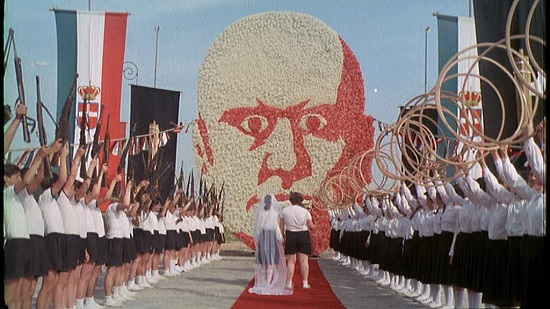
Wedding of school children before giant papier-mache Mussolini
This is not only Titta’s story, but his family’s as well, and Fellini follows patriarch Aurelio (Armando Brancia), uncle Lallo (Nando Orfei), and mother Miranda (Puppella Maggio) during different parts of the film. The film is much more than a mere visual presentation of Fellini's own nostalgia, for it also questions the true validity of one's own memories. This questioning of memory by Fellini is made apparent in the manner in which single scenes can go from “reality” based to fantasy-like parody back to “reality” based in a matter of moments.
One of the more noteworthy examples of this technique is the scene in which El Duce visits the local town square. In the scene the serious yet joyous procession of El Duce eventually turns into a comic-fantasy experience in which schoolchildren are shown happily carrying guns in the imagined wedding of two schoolchildren in front of a giant talking a papier-mache Mussolini looking like a comic bulldog. Moments later the film cuts to nightfall, in which the local Fascists soldiers wreak havoc on the town and afterwards interrogate and beat Titta’s father, forces him to drink castor oil, while a few scenes later Titta and his friends watch Lallo seductively dance with a sexy Scandinavian women then disappear into the darkness.
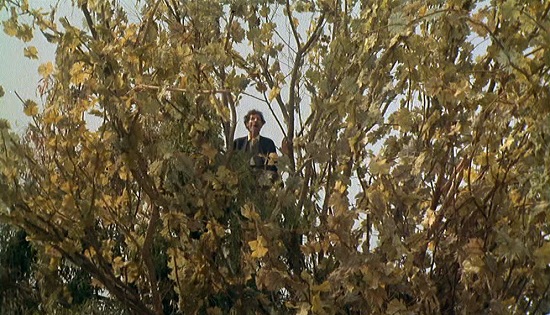
Uncle Teo on top of a tree shouting “I want a woman”
Every day brings a drama. Every summer Titta’s family liberates Uncle Teo from the local asylum for a picnic in the country and one time he climbs a tree and refuses to come down, moaning “I want a woman!” like a lovesick bull. He throws apples at those who try to climb up to him, and finally the family sends to the asylum for help, and a midget nun along with his doctor arrive to order to get Teo down. This nun wears a headdress so exaggerated we never see her face, and form an instant opinion that she is, in fact, a man. The doctor remarks before parting, “He has normal days, and he has not normal days...Just like us.” In this sense, Fellini is able to effortlessly change from light to dark, exhilaration to sadness, and life to death in a matter of seconds, these tonal combinations acting as chapter headings for Titta’s experiences with various relatives.
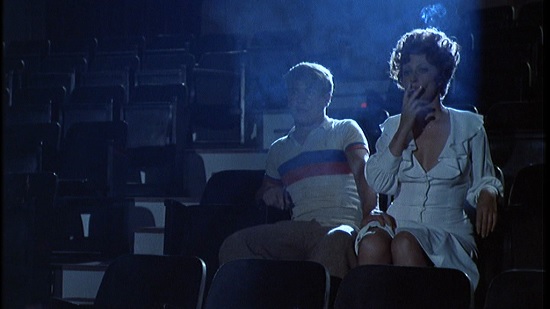
Titta puts his hand on Gradisca’s leg in a movie theatre
Structurally, as said earlier, Amarcord is a slow dance grooving from character to character without the safety net of a cohesive narrative. As a result, Fellini’s film drifts, swirls, and churns through time, reveling in the imagery of specific moments but ultimately pushing forward without much exposition. While Amarcord can be seen as one gigantic flashback, smaller scenes on past discretions create an even wider net of possibility. In one stunning moment, Titta follows Gradisca into an empty movie theater, each editing dissolve moving him closer to her seat. Finally, in a wondrously sensual two-shot, Titta puts his hand on Gradisca’s leg. Enthralled with the movie, Gradisca almost doesn’t notice his advances. “Looking for something,” she finally says, and Fellini abruptly cuts to Titta’s disappointed face months later as he tells his priest the story during confession. When Titta leaves, one of his friends occupies the pew, and the man of God instantly warns him, “St. Louis weeps when you touch yourself.” For Fellini, there is no separation of church, cinema, memory, and sex.
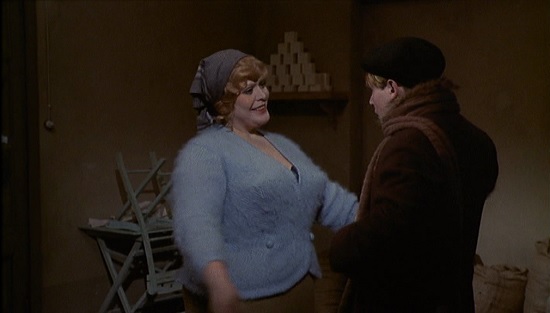
Titta with Tobacconist
Another scene that blurs the real and the imagined is Titta’s late-night encounter with a large busty Tobacconist (she is given no true name within the film) just as she has closed up her shop. The woman, who Titta has fantasized about at an earlier point in the film, playfully flirts with Titta, a flirtation that eventually ends in a moment of extreme foreplay between the two. But the inexperienced Titta is unable to please the tobacconist, and she soon forces him to stop. At this time she acts as if nothing has happened, she gives him his tobacco and shows him out the store. How much of this was real, and how much of this was imagined both within the film and with regard to Fellini’s own experiences? As is the case with many of the other sequences in the film, the answer is left up to the viewer.
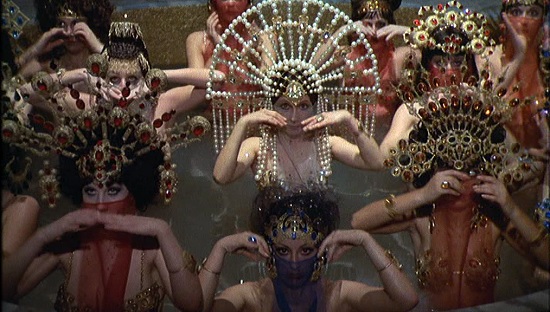
The dance of Sultan’s concubines
Amarcord is a feast of fun and resonates with vivacity. I will just cite an amusing episode, the story of the town idiot who sneaks into a harem of Sultan when arrives in a hotel with 30 concubines. Some concubines pull down a rope for the idiot to climb into their harem. As the idiot plays his flute, the concubines rise from their bed and orchestrate what looks like an Arabian Nights style fantasy sequence.
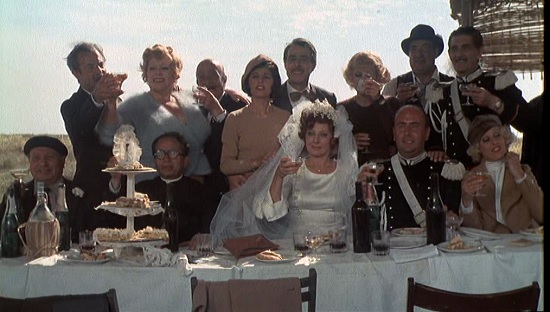
Marriage of Gradisca to a fascist soldier
Local imaginations are inflamed by what must go on at the Grand Hotel, which none of the locals can afford to step foot in, although Gradisca, their heroine, figures in a popular legend there. Gradisca is their carnal fantasy, their symbol of hope, their good-hearted friend. She also supplies Fellini’s loose narrative also leaves plenty of room for other vignettes outside of Titta’s life. For example, the character of Gradisca — the women everyone in the town seems to lust for — weaves in and out of Titta’s life. No wonder, the film comes to its plausible end when Gradisca makes exit after marrying a fascist soldier.
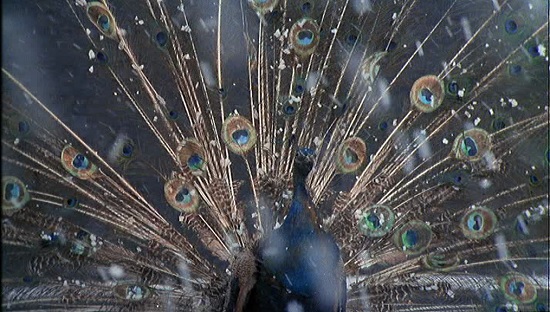
Peacock lands in the snow
This story is culturally valuable because it shows the beauty of meaningfully existing, unchanged, amid destructive and oppressive forces. When a peacock lands in the snow with its beautiful, vibrant blue and green feathers, it exemplifies beauty, simply existing, within harsh conditions. The point of the story is not that the characters of this small Italian town make any world-altering advances, but rather that they maintain what they already have and admire — their sense of community and individual compassion — despite oppressive odds.
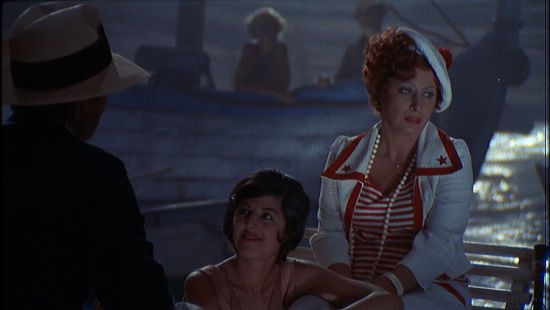
Gradisca expresses her deepest feelings while waiting in a boat to see Rex
Through the interaction of all kinds of characters that one come across in life, Fellini allows his audiences to encounter a town, the families, a community, and the simple life that exists within it. This film is powerful because it is saying that one does not have to defeat oppression to be worthy of being a model, seen and honored. You have only to live, to be yourself — which means to create — to be something powerful and moving.
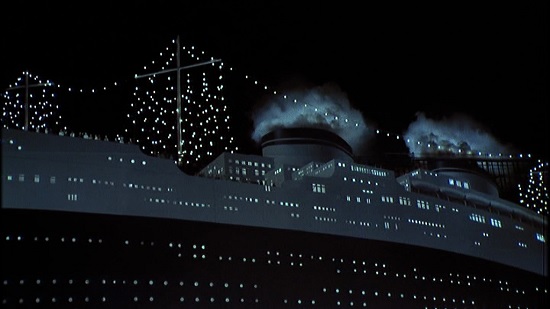
The passage of the fabulous ocean liner SS Rex
If Fellini's fragmented representation of community in Amarcord mimics a circus of different players performing for the audience, the stage is continuously fascinating to watch. Color pops from all angles and each scene is given a formidable texture and detail that dovetails with Titta’s disjointed subjectivity. But Amarcord is a film about the town of Rimini just as much as any individual, a theme Fellini brings to fruition in the movie’s most famous set-piece when dozens of locals put out to sea in small boats to witness the passage of a fabulous ocean liner, the SS Rex, “the greatest construction of the regime.” Waiting, they sleep - till suddenly the luminous (and entirely unreal) vision is towering above them, threatening to swamp them all. The moment is both ecstatic and terrifying with crowd yelling with pride at the symbol of the fascist government responsible for building the vessel. Titta watches on in jubilation, unaware of the subtext behind the devastating symbolism, a telling moment in time adrift in a whirlpool of fractured memory. The scene is as artificial as the “waves” the boats ride on, suggesting how much the national image depends on illusion. This scene has poetic and melancholic side too.

A comical scene where a teacher illustrates the working of a pendulum
Fellini gives his audience mischievous adolescents, oblivious teachers, a “crazy” uncle, a humorous grandfather, an idealistic and extremely feminine beauty, a generous but sickly mother and her easily-angered husband, dissatisfied workers, a story-telling lawyer, a prince, and a lying snack vendor. And none of these characters is ever treated inhumanely, or as being of any less value than any other.
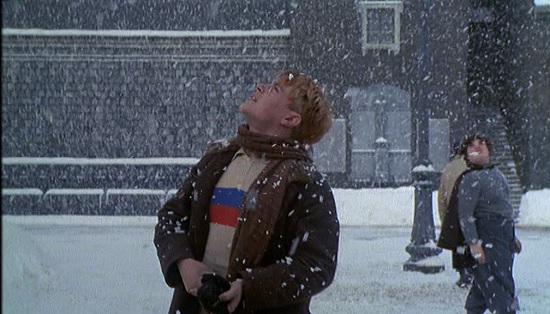
Titta and his friends enjoying snow
There’s little question of Fellini’s visual mastery, as the look of Amarcord amazes, with one image after another lingering in the brain courtesy of Fellini and cinematographer Giuseppe Rotunno’s thoughtful, imaginative compositions. The film’s greatest asset is its ability to be sweet without being cloying, due in great part to Danilo Donati’s surrealistic art direction and to the frequently bawdy injections of sex and politics by screenwriters Fellini and Tonino Guerra. And the score by Nino Rota — who also wrote the music for the first two Godfather films — is a treat from start to finish.
Amarcord reflects the fallacies of past experiences by painting them messily on a textured canvas so we may try to understand them in a new way. Still, these images are aloof, separate from reality as all dreams are after so many years of deconstructed yearning. In his essay “Federico of the Spirits,” film scholar Sam Rohdie states Fellini was “a great liar.” But there's some layer of truth to every elaborate fib, and with Amarcord, Fellini wants each viewer decide which lies are worth remembering, and which ones should disappear into the night
A series of “Hundred Favorite Films Forever”
28-Feb-2013
More by : P. G. R. Nair